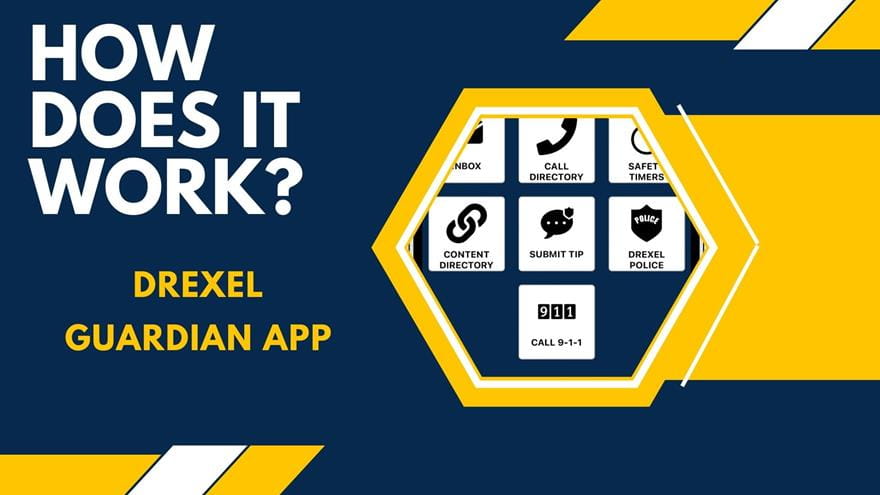Faculty and Staff Town Hall Recap: Vaccines, Return to Campus and What Comes Next

Please visit the ‘Drexel’s Response to Coronavirus’ website for the latest public health advisories.
On Jan. 19, Drexel University leadership shared information with faculty and professional staff during a Virtual Town Hall about the steps that are being taken to safeguard the Drexel community during the COVID-19 pandemic.
During the hourlong event, leadership from Drexel organizations like its Return Oversight Committee and departments and offices of the Provost, Human Resources, Student Life, Facilities, and Research and Innovation provided updates and statuses of protocols related to their units and its impact on the University community. They also answered questions submitted by faculty and professional staff.
Some of the panelists’ thoughts and responses have been excerpted in a lightly edited transcript below.
On the possibility of updating the phased return to campus for faculty and professional staff past the currently planned April 6 Phase 5 return to work:
Senior Vice President and Chief Human Resources Officer Megan Weyler: I think our key topic here is that we have to remain flexible and whether we're building plans to move forward and address spring term with reopening fully of campus versus having to pull back and do a slower phased in approach, we haven't yet made that decision.
At this time, those faculty, professional staff who were asked to continue to work remotely did receive a letter stating that they were expected to return for spring because that was the latest phase. There's definitely opportunity for continued phases, depending on how the roll out of the vaccine and our opening of campus occurs.
Vice Provost for Community Health Care Innovation and Director of the Return Oversight Committee Marla Gold, MD: With the nature of COVID, things are fluid and they change. We assume that in the spring, as it warms up, we'll be able to even allow more populations back on campus. But we're working through that now.
On vaccine distribution and requirement at Drexel:
Marla Gold: There are overall shortages of vaccine in Philadelphia, but more is coming. The city has been in Phase 1A, which includes health care workers; those working directly with the virus, such as clinical settings, research settings and so on; staff and patients in clinical settings; our testing units and health care students.
I do want to say that Drexel is working with the [Philadelphia] Health Department to ensure a vaccine is offered to many members of the community. This week we will be hosting with the Health Department, under their guidance, a small clinic for 1A students who are in hospital settings and at risk of COVID. We want them to keep getting their training as they become physicians and nurses, et cetera, and also importantly, our researchers who are working hands on with samples of coronavirus of SARS COV-2. And in addition, we still have clinical settings … where we want to make sure people who work with patients … have access to vaccine. Having said that, the guidelines from the city remain fluid and I know frustrating. … As we put out in a memo, as other institutions have done, we're doing our best to advocate strongly for everyone here.

We have no indication that the vaccine will come to the University for all of those that are here. But if it does, and we're advocating for that, we are ready to distribute vaccine as best as we can under the phases. And the guidance from the city, vaccine is not mandated. And I remind you that it is emergency use authorization, but not fully FDA approved at this time, although the data on it is very good.
At Drexel, for anyone who has access to vaccine or is being vaccinated again, we do have a limited amount of vaccine for 1A because we don't have a central hospital. We went to the city directly for our 1A people, whereas the other institutions of higher end had their vaccine come in through hospitals and then to their 1A individuals that I mentioned earlier.
People who are fully vaccinated still remain in our testing program. We still advise you to get tested. And in addition, if you are vaccinated, you must still wear masks. There's no evidence yet and the studies are not out yet as to whether or not a vaccinated person is still able to transmit virus even though they don't get clinically sick. So you don't have any symptoms, you feel well, but you still may be able to transmit. And the reason for testing is that these are really good vaccines in both cases, the two that are out there, Pfizer and Moderna, up to 95% effective, but that still leaves upwards of 5% who still contracted the virus. And therefore, we're going to continue to offer testing to that population.
On the possibility of continued remote work post-pandemic:
Megan Weyler: We were all forced to work remotely, but for many years we've had flexible work arrangements policy in place at the University. It was utilized probably more sporadically. And there's lots of opportunity for flexibility, including remote work. As we start to look at what this post-pandemic world will look like and how it will impact us at the University, these are conversations that have been occurring with the senior leadership team.
In fact, we have many areas currently working across the University to develop a white paper to be presented to cabinet to find ways to expand our remote work opportunity. There are quite a few benefits in doing so, both from an employee perspective and the flexibility of working remotely, as well as from a University perspective on space allocation that we need.
On what happens with symptomatic testing, exposure and testing positive for COVID-19:
Drexel’s Director of Student Health Services Janet Cruz, MD: An emphasis for when the appropriate time is for symptomatic or exposed: we want individuals that have been exposed to wait at least 24 hours before they get tested. That's to minimize the chance for a false negative test for individuals that have been exposed. We want them tested around five to seven days after their last exposure. Our case investigators and our contact tracers will walk you through when the appropriate time for testing in those last two buckets.
So what to do with a positive test? If you're tested here through Drexel’s testing sites, you will get a call from one of our medical personnel.
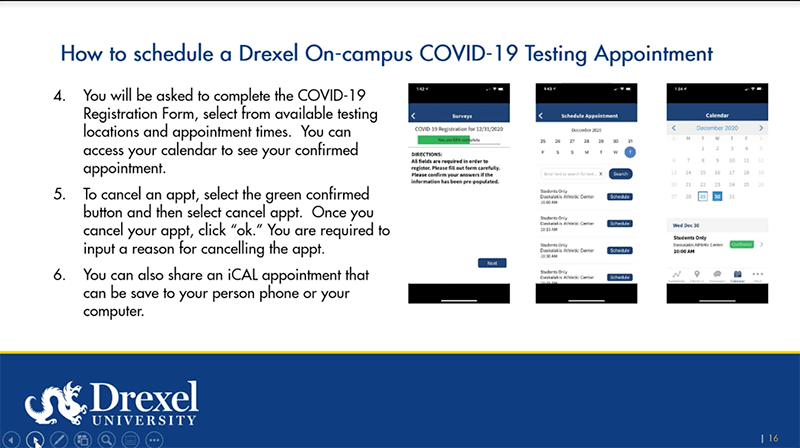
That's part of our case investigation: contact tracing, informing you of the test, as well as one of our case investigators getting a better understanding of where you might have been exposed or what your work environment looks like. They will also provide information regarding isolation or quarantine when appropriate. The other step that I would recommend for individuals is, regardless of where you get your test, please contact your PCP or your primary care physician; they will know you best. They know what your comorbidities are or what other medical problems you may have so that if there is additional medical treatments that need to be done because you're now COVID positive, they will assist you with that.
For individuals that have gotten tested outside of the Drexel system: I ask that you report and there's a couple reasons why. One, we want to make sure that we connect you to the right people, that you get the right information regarding isolation and quarantine, and that we connect you with the respect of our business partners so they could get you the right information regarding an absence from work, etc.
The last piece regarding a positive test: our case investigators and our contact tracers will walk you through the return to work procedures currently for individuals that have tested positive. We work together with occupational health to get you back to work as soon as possible.
So from a self-report or a positive test result, our case investigation and contact tracing team will communicate with you, provide information, but also give the University information regarding if individuals were in a workplace, if that work environment needs to be cleaned appropriately. We engage with different systems, including environmental, to make sure that these measures are done in a timely manner. Our case investigators and contact tracers will call people within 24 hours of receiving a positive result or 24 hours of being notified that they might have exposed someone else.
….This is the big part of what our case investigation and contact tracing does. They'll call anyone that's been identified as being positive. They'll walk these individuals through when their infectious period was. So just for everyone here, it starts two days before the start of symptoms or two days prior to a positive test. And they'll walk through literally what that individual did during that infectious period. We have a contact tracing team that will then notify any individual that may have been in contact with an individual that was positive.
The notification will be anonymous, meaning a lot of these exposed individuals will get a phone call saying you were exposed on this date. We don't reveal who or exactly how the exposure happened. And then those individuals that have been exposed will be given education on how to quarantine. Our contact tracing team will assess that they can quarantine safely, meaning they must have their own bedroom and their own bathroom and then when to test.
On the assessment of areas on campus open for winter term:
Executive Director of Environmental Health & Radiation Safety John Chase: We have 249 spaces that we're going to be using for classrooms. This includes all campuses and our lease locations. I'd like everybody to know that we've done a full assessment on the systems of servicing these areas. Some of that assessment is done by third-party engineers and other portions of it were done by our in-house professional engineers. The systems, to the extent possible, have been reprogrammed and or manually set for enhanced service. We would be following the ASHRE — that's the American Society of Heating, Refrigeration and Air Conditioning Engineers — 62.1 recommendations for occupancy during a pandemic, as well as CDC and DLH guidelines. Of those 249 spaces, we found that 90 of them, that's about 36%, needed supplemental treatment in the form of standalone HEPA filtration units. We currently have about 119 units deployed in those spaces. We also have signage on all of these areas that say, “sit here,” “don't sit there,” and buckets of sanitizing wipes stationed in each area as well.
Additionally, we have 42 spaces for independent workspaces, independent work and or independent study. Some of these are controlled by individual colleges, but most are available through the Libraries Space Reservation system. I would encourage you to check those out. All of these areas have been assessed and treated, as noted above for the classrooms.
All of our entrances, stairways, elevators, restrooms, classrooms that are scheduled for use and other forward-facing areas have been provided with certain types of signage, noting maximum occupancy reminders to wear masks and hygiene, social distancing stickers noting, like I said, where to sit and not to sit and, in some instances, where to stand in bathrooms, which urinals or sinks to use, etc.
And Plexiglas barriers have been installed in all of our forward-facing areas, at least with the groups that we’ve worked with so far. We've also made sure that hand sanitizer is readily available. It's most notably present in entrances to buildings and in elevator lobbies, although the team has put together tremendous efforts in trying to make our spaces as safe as possible.
I just wanted to take a moment and acknowledge the fact that we're not perfect if we have missed anything. If something seems amiss in your particular area, please reach out to us and let us know. I'm giving you all my email here. Please make note of it if anything seems out of order, please give it to me. It's our true intent to want to make the areas as safely as safe as possible.
On relevant HR updates and reminders regarding the campus experience:
Megan Weyler: We are here with over 1,900 faculty and professional staff that are expected to be on campus during the winter term. So that's about an increase of over 400 individuals who were here on campus for the fall. So as we slowly and safely make our way back, I know that whether you are on campus or remote, it's your hard work and dedication that really is allowing us to make each transition safely for those who are coming to campus.
Our Drexel Business Services team was able to address many of the questions we have coming through regarding what's open on campus and what to expect upon returning. So whether it's access to the gym or just where you can grab lunch, the Jan. 12 edition of DrexelNow does have all the answers. Of course, you can also find many of these resources on our COVID-19 web site as well. You'll note that parking remains free of charge this term and that the shuttle service is operating along all three campuses for those faculty and professional staff who are not on campus on a full-time basis and they live outside of the city.
Our payroll department has worked in collaboration with I.T. to provide you with the ability to adjust your work location percentage. And this certification process will allow you to report the correct percentage each pay and avoid filing for an end of your adjustment if you are in that situation and would like more information. Please take a look at comptroller’s website to take advantage of the opportunity.
If this is your first time returning, you'll also receive your welcome bag, along with your Drexel-branded face mask, your backpack, as well as personal hand sanitizers.
For those of you who have concerns regarding coming to campus due to a medical condition for yourself, please reach out to our disability specialist to discuss any accommodations that may be needed. And for all other personal questions, you can reach out to your HR business partner for assistance.
For those who have children, we know how difficult this time has been if you have school-age children who would like assistance with homework or with tutoring, we have our new Junior Dragons program to provide those resources free of charge. We do have some amazing graduate and undergraduate students who are available for online drop-ins as well as prescheduled sessions.
And last but definitely not least is just please take care of yourself with a new year beginning, you have the opportunity to gain your wellness credits and to keep yourself mentally and physically healthy. But if you or a family member are in need of assistance, confidential counseling is just a call away. Or if you're looking for an opportunity to engage remotely with colleagues, please go out and check out our Ten at 10 program. But again, above all else, please take care.
On whether the University will close if COVID cases hit a certain threshold:
Marla Gold: We're not considering a set threshold for the change because it’s a lot more complex. What I would say to you is among the things we look at is not just the percent, but also the rate of rise, our ability for isolation and quarantine, where those cases or individuals are and any information we get with the city. So if numbers begin to rise or we feel that we have an issue, a cluster or anything like that, we would be partnering with the Health Department and working together to make our decisions from there.
On what was learned from the fall:

Marla Gold: The College of Medicine, the College of Nursing and Health Professions, the School of Law, our graduate and research programs successfully ran without interruption in the first half of the year, particularly the first quarter, and they are continuing currently.
…. Overall, our fall test positivity was at or below 2%, except post Halloween and Thanksgiving. Currently, as I'm talking to you today, the state’s running about 11 to 12% positivity … and the city around 8 to 9%. World Health Organization wants us well below 5%.
Janet Cruz: So throughout this process, we've been doing contact tracing, case investigation for our campus since March. We do have weekly meetings with the public health department and other agencies in the area to get a good understanding of what's happening in our college campuses here in Philly.
With all the measures that we've put in place, we're seeing that a lot of the transmission really isn't happening in the workplace. It isn't happening in the classrooms. It's happening where we suspected, right? In home environments when individuals may be engaging with friends or engaging with other members in small gatherings. So that is our top priority in terms of getting individuals identified, tested and getting the right education out there. We do know that from other campuses, residence halls tend to be a little bit higher risk. So we have altered our protocols and we have altered the amount of individuals that are staying in these locations for that reason.
On testing times, occurrences and types:
Janet Cruz: Entry testing and surveillance testing for our student population is key and for an employee population, offering testing regularly to make sure that we're catching individuals that may be bringing in COVID from their home environments. We know that student outbreaks or college outbreaks can trickle down and impact vulnerable communities within our community, within our home environments. And this is why we've stressed bringing in our own surveillance testing here at Drexel.
…. So once you get tested, if you get tested internally through one of our testing sites, the results will go into your Drexel Health Checker app. Right now, our turnaround times are within 24 hours. So if you get tested today, your results will be in your [app] by tomorrow. For those individuals that have difficulty seeing the results or if they have any issues, please contact covidtesting@drexel.edu.
…. We do PCR only for our testing sites….As I mentioned, the results come into your Health Checker app within 24 hours. That's our goal. And we're meeting that goal currently for individuals that are asymptomatic, especially for students, its once weekly. For employees, it’s once every other week that we offer testing.
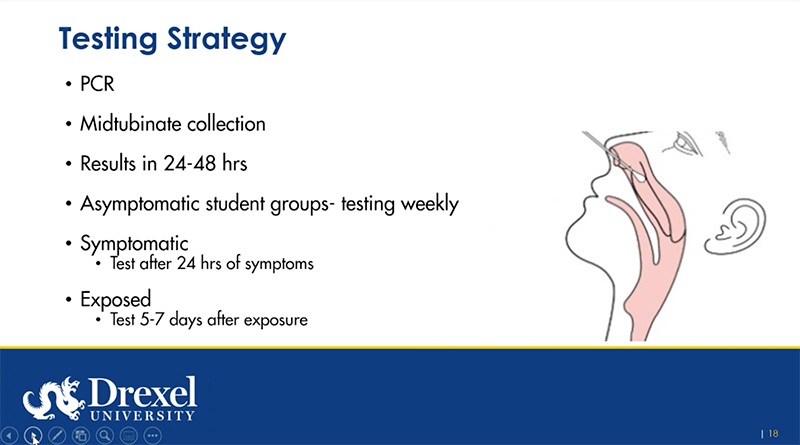
Marla Gold: Please forgive us if we lag a little bit on updating the website. But you do not need a negative test to necessarily enter a building. And we're not doing as we did in the first quarter, all baseline testing for everybody. We've been showing that individuals who work here have a low risk and also the way that we're coming in much slower than originally planned in phases. And it doesn't make sense to do an altogether baseline testing.
On students returning to campus this term:
Senior Vice President for Student Success Subir Sahu, PhD: In terms of the reactivation of campus and bringing undergraduate students back to campus: we commenced on Saturday and in a typical year we have close to 4,000 students who live in Drexel Housing, which is our residence halls and Greek properties.
This year, for a variety of different reasons, that number is closer to 1,000. We've implemented a lot of different pieces from a health and safety perspective. Students don't have roommates. They have their own rooms. We put aside certain halls for quarantine and isolation spaces. We put in social distancing measures and common area spaces where we eliminated furniture.
We worked with our external partner, University and Student Services (USS), who helped move in about 500 of those students to campus this weekend. We coordinated with Dr. Cruz and her team from a Student Health Center perspective. Our students received the COVID test before their key.
…. We have the rest [of the students] coming in for the rest of the week. During this quiet period before moving into in-person classes for next week, campus is reopened and reactivated. So many of our spaces are reopening for students to use again — much like our common area spaces and the residence halls, with a lot of social distancing measures in place. There'll be some limited hours, but we want to make campus feel as active and lively for the students that are here.
And it's good to remember that in addition to the thousand students living with us, we have about 2,500 who live in our American Campus Communities properties. We're proud to say in coordination and partnership with us, ACC continues to offer rent abatement to our sophomore-year residency program. Between 700 and 800 students took advantage of that opportunity, which led to their occupancy on the ACC side. And then we have several thousand more who live in the surrounding community.
…. Our campus spaces are open, but with social distancing and in terms of occupancy numbers in mind. And then we put in policies around students having to follow, like no guests in the residence halls. Even this weekend, the students moving into campus, parents and families weren't allowed into the spaces. That's part of the reason we had our external service so that students wouldn't have to worry about carrying a lot of boxes in. Everything that we're doing is really driven with health and safety in mind.
On how students have been responding to Drexel’s COVID-19 measures:
Subir Sahu: We feel good about our testing systems in place and we believe in our students. We believe that our students who are coming to campus will follow the policies and rules that we set out for the campus, for the students that have come. We've had success in working with them in terms of having them wear masks, having them socially distance, just not engaging in large groups. And when issues do come up, we're able to address them, whether it's through student conduct or through one-on-one conversations.
Janet Cruz: I just want to emphasize that a lot of the students are very receptive to the education that we give them. In a lot of times, they will present very early, meaning they have a sore throat this morning and I'm already hearing it in the clinic. So they're very receptive. They're very engaged. And if there are other people that have been involved or they might have exposed, they openly share that.
I haven't had a huge issue with compliance at all. If anything, they'll say, “Hey, you know, I might have exposed this person. It's also a Drexel student. Can they come to the site? Can they come to Student Health as well?” I think they have been very engaged. And I think there's an understanding that college is going to be a little bit different and they are coming up with creative ways to interact that doesn't involve face-to-face. I think we will be pleasantly surprised with our young adult population.
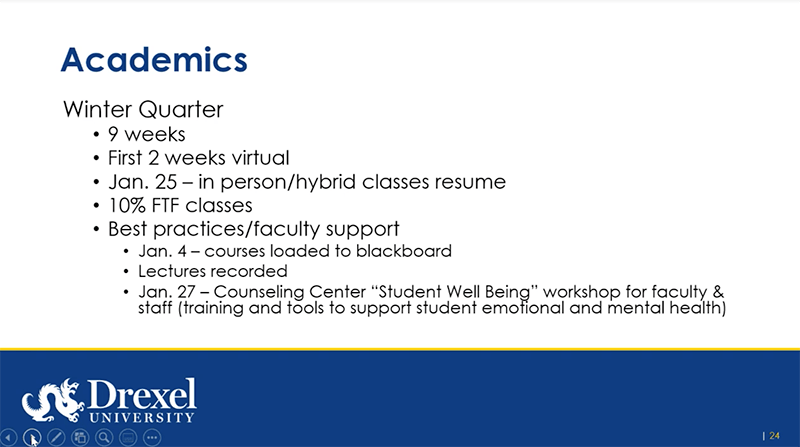
On looking at academics and planning for the spring term:
Executive Vice President and Nina Henderson Provost Paul E. Jensen: We are working with the deans and with the registrar and others on the plan for the spring. We will continue to increase activity as long as it's permissible in terms of safety and health. And I think the question that we have is we focused in the winter on our freshmen and our seniors. We now need to think about our sophomores and juniors as well. So we're looking at whether it's possible to offer at least one class that's face to face or hybrid for every student if they choose to, to have that type of experience.
We're also currently working on the spring grading policy. In fact, I'll be attending Faculty Senate later today where that will be one of the points of discussion. So we should have an announcement about that forthcoming this week, I believe.
On research activity:
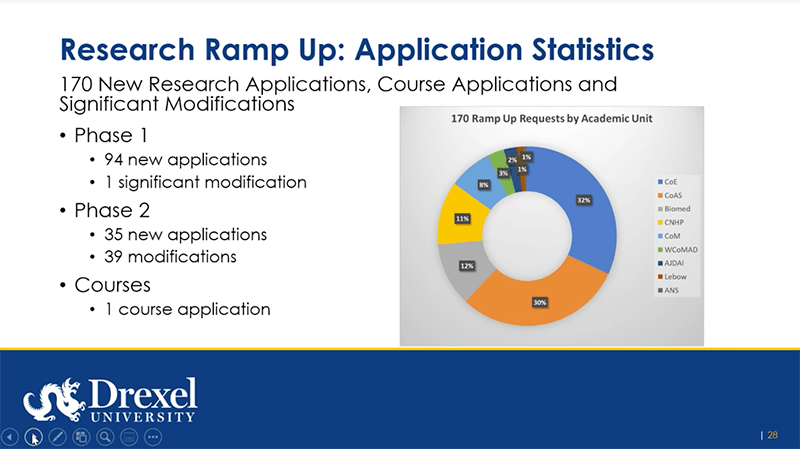
Executive Vice Provost for Research Aleister Saunders, PhD: We've had a robust research wind up process for on campus and clinic-based research activities…. Right now, we're in phase two, that’s 66% of regular density. What's different now that we're in January, undergraduates can participate in ways they weren't able to before. So now they're able to take for-credit bearing activities as part of research ramp up. They were unable to do that in the fall.
On athletics and recreation at Drexel:
Marla Gold: Athletics plans have been approved by the Philadelphia Department of Public Health. So tier one sports such as basketball, and potentially even wrestling, go through a very rigorous review by the department. And then we're told if we have permission to move forward and you can see that basketball teams, men and women have been playing, our facilities have been readied, HVAC systems all reviewed and addressed where necessary.
Subir Sahu: Our recreation center is opening up next Monday, again, following the same parameters that we had before with limited occupancy and folks who can sign up to come in and use the Rec Center.
Our men and women's basketball team have been active. And in season they're going through daily testing and doing great. I'm really proud of the men and women's basketball teams and their coaches. We're working closely and hand-in-hand with the Philadelphia Department of Public Health and following their guidelines as it relates to testing and just the overall protocols for our athletics teams.
On air exchange rates in areas on campus:
John Chase: So, as previously noted, we used Drexel’s and third-party engineers, but I also want to give a shout out to the College of Engineering, Chuck Haas [PhD, LD Betz Professor of Environmental Engineering], and Mike Waring [PhD, Civil, Architectural and Environmental Engineering Department Head and Professor], who worked with me specifically and individually to us to take a look at the way that we were doing these assessments and to see if our approach was sound.
In essence, it varies, but our target for the amount of outdoor air per person ranges from 7.5 to 10 CFM per person, depending on the utilization of the space. And our air changes have a target of six air changes per hour or air change equivalents. That number will be slightly reduced in areas that have extremely high ceilings because of the mixing and just the big data behind that.
In This Article
Drexel News is produced by
University Marketing and Communications.

